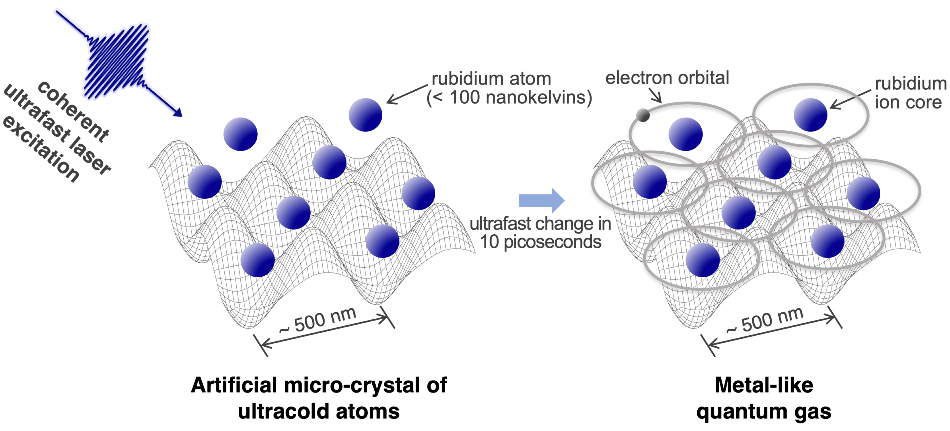Jun 23 2020
A complex competition between kinetic energy usually determines the electronic characteristics of condensed matter.
 Schematic of the metal-like quantum gas. Image Credit: National Institutes of Natural Sciences/Institute for Molecular Science.
Schematic of the metal-like quantum gas. Image Credit: National Institutes of Natural Sciences/Institute for Molecular Science.
The aim of this kinetic energy is to superimpose and delocalize electronic wave functions over the crystal lattice, and localize the interactions between electrons. On the contrary, the gaseous phase is defined by valence electrons that are closely localized around the cores of ionic atoms in discrete quantum states that have well-defined energies.
As an unusual hybrid of both scenarios, individuals may speculate about the state of matter that is likely to be generated when a gas of separated atoms is abruptly activated to a state, where electronic wave functions spatially superimpose just like in a solid. But so far, it has been impossible to create such an exotic phase of matter at the theoretical level.
In a new study, Professor Kenji Ohmori from the Institute for Molecular Science, National Institutes of Natural Sciences in Japan, and his colleagues have now achieved this unusual hybrid with superimposing high-lying electronic (Rydberg) wave-functions produced coherently in less than 10 picoseconds (pico is equal to one trillionth). This feat was achieved by performing ultrafast laser excitation in an artificial micro-crystal of ultracold atoms.
The extent of spatial overlap is intensely adjusted with accuracy and precision of almost 50 nm (nano is equal to one billionth). This unusual metal-like quantum gas under excellent control and long-lived, decaying in nanoseconds, paves the way for a whole new regime of many-body physics for replicating the ultrafast many-body electron dynamics governed by Coulomb interactions.
The experiment was carried out with a group of 30,000 rubidium atoms existing in the gas phase. The rubidium atoms were cooled to a less than 10-millionth of 1 K temperature, over an absolute zero temperature by laser and evaporative cooling.
Such ultracold atoms that exist in the energetically lowest quantum state, called a Bose-Einstein condensate, are placed into a cubic lattice of optical traps developed using counter-propagating laser beams. This results in an artificial micro-crystal containing 30,000 atoms, with a nearest neighbor distance of 0.5 µm.
Measuring a few tens of micrometers in size, this micro-crystal was subsequently irradiated with an ultrashort laser pulse, the pulse width of which was 10 picoseconds.
The researchers then noticed that an electron limited to each of the adjacent atoms was activated to its massive electronic orbital (Rydberg orbital)), so that the atoms spatially superimposed with one another. The extent of the overlap was finely regulated with precision and accuracy of almost 50 nm by altering the laser frequency that chooses the orbital.
When the orbitals of such loosely coupled electrons superimpose one another and the atoms begin to share their orbitals, they ultimately enter into a novel metal-like quantum-gas regime. For the first time, Professor Ohmori and his colleagues have successfully produced a metal-like quantum gas.
It is hoped that this unusual matter phase will serve as a path-breaking route for quantum replication of ultrafast many-body electron dynamics governed by Coulomb interactions. Such a platform would improve one’s interpretation of physical characteristics of matter, like magnetism and superconductivity, and may play a role in disruptive breakthrough in the development of novel functional materials.
Journal Reference:
Mizoguchi, M., et al. (2020) Ultrafast Creation of Overlapping Rydberg Electrons in an Atomic BEC and Mott-Insulator Lattice. Physical Review Letters. doi.org/10.1103/PhysRevLett.124.253201.